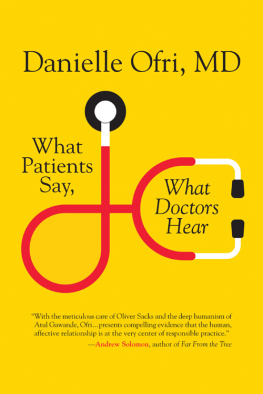SEEING PATIENTS
A SURGEONS STORY OF RACE AND MEDICAL BIAS
With a New Preface
AUGUSTUS A. WHITE III, MD
with
DAVID CHANOFF
H ARVARD U NIVERSITY P RESS
Cambridge, Massachusetts | London, England
Copyright 2011 by Augustus A. White III and David Chanoff
Preface to the Paperback Edition copyright 2019 by Augustus A. White III and David Chanoff
First hardcover edition published as Seeing Patients: Unconscious Bias in Health Care, Harvard University Press, 2011
ALL RIGHTS RESERVED
First Harvard University Press paperback edition, 2019
Photo courtesy of Getty Images.
Cover design: Tim Jones
978-0-674-04905-5 (cloth: alk. paper)
978-0-674-24405-4 (EPUB)
978-0-674-24407-8 (MOBI)
978-0-674-24406-1 (PDF)
The Library of Congress has cataloged the printed edition as follows:
White, Augustus A.
Seeing patients: unconscious bias in health care / Augustus A. White III, with David Chanoff.
p. ; cm.
Includes bibliographical references and index.
ISBN 978-0-674-24137-4 (pbk.)
1. White, Augustus A. 2. African American surgeonsUnited StatesBiography. 3. Discrimination in medical care. 4. African AmericansHistory. 5. Medical education. I. Chanoff, David. II. Title.
[DNLM: 1. White, Augustus A. 2. Healthcare DisparitiesUnited States. 3. PrejudiceUnited States. 4. African AmericansUnited StatesPersonal Narratives. 5. Cultural CompetencyUnited States. 6. OrthopedicsUnited StatesPersonal Narratives. W 84 AA1 W582s 2011]
RD27.35.W53A3 2011
362.108996073dc22 2010014762
With much love
To my wife, Anita,
Who enabled me to work hard
and
To my three daughters,
Alissa, Atina, and Annica,
Who inspired me to try hard
and
To my grandchildren,
Who I trust will learn from this book
CONTENTS
When Seeing Patients was first published in 2011, a shock wave was reverberating through the world of health care, shaking fundamental beliefs about the relationship between doctors and patients. A few years earlier, the Institute of Medicine had published a report, Unequal Treatment: Confronting Racial and Ethnic Disparities in Health Care, which brought together research that had surfaced in hundreds of studies but had been so scattered it hadnt galvanized attention or created a call for action. Unequal Treatment documented in incontrovertible detail the fact that African Americans and Hispanic Americans received health care that was far inferior to the care provided to their white fellow Americans. Blacks received far fewer standard cardiac procedurescatheterizations, angioplasties, bypass surgeriesthan whites. They received fewer kidney transplants and lung cancer surgeries, and even less pain medication for bone fractures. The mortality rate from the leading causes of death was one and a half times greater for blacks than for whites. Many of the same inequities held true for Hispanic Americans. Something lethal was going on, and it needed to be fixed.
At the time, this was a revelation to most doctors. Now, sixteen years after Unequal Treatment, the fact that the American health system is riven by discrimination is universally acknowledged. We now know that biased care doesnt just impact the health and lives of African Americans and Latinos. Numerous studies have shown the disparities suffered by women, gays, the elderly, and others. Thirteen groups have been documented in all: Native Americans, Asian Americans, the Appalachian poor, immigrants and refugees, those with disabilities, obese people, prisoners, and LGBT people, in addition to women, Latinos, African Americans, and the elderly. As we pointed out in the original edition of Seeing Patients, each specialty right down the lineorthopedics, gynecology, cardiology, oncology, psychiatryhas its own grim history of discrimination.
Today our understanding of disparate care goes far beyond the rudimentary grasp we had even a few years ago. Medical schools and professional organizations are making efforts to address the problem. There is progress. Our health-care institutions now teach culturally competent care, mindfulness, and professionalismthat is, a commitment to self-awareness, patient autonomy, and social justice. But we have not yet faced the true implications of inequitable care.
Inequitable care means, in plain language, that we value some lives less than others. Physicians have the ability to ease suffering, cure disease, and save lives. Unequal care means that certain groups have less access to these benefits. In other words, the human beings who constitute these groups are lower down on the scales that measure the value of life. Most physicians consider themselves to be, and strive to be, humane, compassionate, and egalitarian caregivers. Yet the statistics reveal deeply distressing discrepancies in the outcomes of those they care forand this is true even when insurance coverage and socioeconomic factors are accounted for.
Seeing Patient s tells a personal story, but it also explores some of the root causes that steer all of us, physicians and non-physicians, into discriminatory behaviors, operating beneath the surface of conscious thought and moving us without our realizing it. When I was growing up in Memphis, it was widely believed that there were significant discrepancies in aptitude and intelligence between blacks and whites. Most black doctors saw only black patients. White doctors tended to treat black patients with the condescension and patronization common in that society. The assumptions undergirding the old system have had a stubbornly persistent, if mostly unspoken, afterlife. They persist in the national psyche. They are alive in the subcurrents of our emotional lives.
In Seeing Patients, I look at the deep psychological processes at work and at the neurophysiology that underlies the impact of hidden emotion on rational thought.
Feelings, neuroscientist Antonio Damasio tells us, come first in development and retain a primacy that pervades our mental life. They constitute a frame of reference and have a say on how the rest of the brain and cognition go about their business. The book shows how subconscious stereotyping, a primary function of human thinking, leads us into likes and dislikes that stubbornly resist our efforts to erase them from our thinking. We all make stereotypic assumptions and unwittingly make discriminatory judgments, writes David Schneider, professor of psychology and cognitive science at Rice University. It happens with race, it happens with disability. It happens with gender, age, and physical appearance. It happens because thats the way it is: Our mental apparatus was designed to facilitate quick decisions based on category membership.
Understanding causes, no matter how intractable they might seem, is a prerequisite to addressing and counteracting them. When it comes to racism, sexism, ageism, and the other isms that constitute the litany of prejudice (and contribute so powerfully to health-care disparities), physicians are often unwitting perpetrators, but they are also ideally placed to embrace the ideals of equality and equitable treatment. This is because physicians work is humanitarian at its very core. Doctors whole business is to heal other human beings who, for the most part, are not close family or friends, who are to one degree or another strangers. And thatcaring for strangersis as good a definition of humanitarianism as there is. In that sense doctoring is the paradigmatic humanitarian profession.
Physicians are equipped by training and experience to oppose the subterranean winds that bend the mind toward the derogation of those who are different from ourselves. They see the equality of humankind in their daily practice. The suffering illness brings is the same for us all. Discomfort does not discriminate. Nor does pain. Pain is the same for you and me, black and white, Hispanic and Asian, male and female. For surgeons like myself, the equality of humankind is a living exhibit every time we operate. Once you open up the skin and look inside, everybody is the same. Underneath the surface we are all brothers and sisters. The reality of the body tells you this. The reality of the spirit tells it, too. For everyone, anxiety and fear are the fellow travelers of pain and suffering; so are courage and fortitude.










